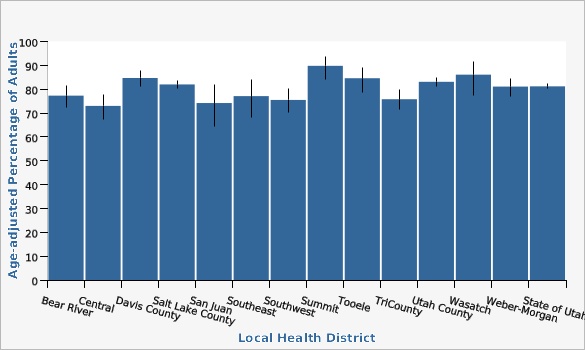Complete Health Indicator Report of Blood Cholesterol Screening
Definition
Percentage of adults aged 18 years and older who have had their cholesterol checked within 5 years.Numerator
Number of BRFSS survey respondents aged 18 years and older who have had their cholesterol checked within the past 5 years.Denominator
Number of surveyed adults aged 18 years and older.Data Interpretation Issues
BRFSS data are self-reported. Patients may not be aware of the specific tests conducted in clinical settings on their blood samples. However, BRFSS is a large, population-based survey that provides the only state-level assessment of high blood cholesterol screening and prevalence every 2 years. Due to small numbers, data by race, ethnicity, and geographic area are based on combined years. Some estimates may be statistically unreliable and should be interpreted with care.Why Is This Important?
High blood cholesterol is a leading risk factor in the development of atherosclerosis and coronary heart disease (CHD). The risks associated with high blood cholesterol can be reduced by screening and early treatment, which includes medication and lifestyle changes. Lifestyle changes could include eating a diet low in saturated fat and cholesterol, engaging in moderate to vigorous exercise on a regular basis, and reducing excess weight. Because high blood cholesterol does not produce obvious symptoms, experts recommend that all adults aged 20 years and older have their cholesterol levels checked at least once every 5 years to help them take action to prevent or lower their risk of cardiovascular disease.How Are We Doing?
The percentage of Utah adults who have had a cholesterol check in the last 5 years has been increasing since 2015. The most recent estimate in 2021 indicates that 81.2% of Utah adults had at least one cholesterol screening in the past five years, rising from 70.3% in 2015 (age-adjusted rates).How Do We Compare With the U.S.?
According to the Centers for Disease Control and Prevention (CDC), Utah has consistently had lower rates of cholesterol screenings compared to other states and the U.S. as a whole. In 2021, 81.2% of Utah adults had had a cholesterol screening in the past five years. U.S. data for 2021 indicates that 86.4% of adults had a cholesterol screening in the past five years. The 2021 data is the most recent data available for the U.S. at this time.What Is Being Done?
The Healthy Environments Active Living (HEAL) was previously known as the EPICC Program. EPICC was formed in 2013, consolidating three Utah Department of Health programs (Diabetes Prevention and Control Program, Heart Disease and Stroke Prevention Program, and the Physical Activity, Nutrition and Obesity Program). The purpose of the consolidation was to ensure a productive, collaborative, and efficient program focused on health outcomes. In 2021, the program name was changed to HEAL. HEAL aims to reduce the incidence of diabetes, heart disease, and stroke by targeting risk factors including reducing obesity, increasing physical activity and nutritious food consumption, and improving diabetes and hypertension control. The program is organized around four domains: *Domain 1: Epidemiology and Surveillance--gather, analyze, and disseminate data and information and conduct evaluation to inform, prioritize, deliver, and monitor programs and population health. *Domain 2: Policy and Environment--environmental approaches the promote health and support and reinforce healthful behaviors (statewide in schools and childcare, worksites, and communities). *Domain 3: Health Systems--Health system interventions to improve the effective delivery and use of clinical and other preventive services in order to prevent disease, detect diseases early, and reduce or eliminate risk factors and manage complications. *Domain 4: Community Clinical Linkages--Strategies to improve community-clinical linkages ensuring that communities support and clinics refer patients to programs that improve management of chronic conditions. [[br]] The primary program strategies include: *Increasing healthy nutrition and physical activity environments in K-12 schools *Increasing healthy nutrition and physical activity environments in early care and education (childcare/preschool) *Increasing healthy nutrition and physical activity environments in worksites *Improving awareness of prediabetes and hypertension for Utahns *Improving the quality of medical care for people with diabetes and hypertension *Improving the linkages between healthcare providers and supporting community programs for Utahns with diabetes and hypertension *Improving access and availability to community health programs for Utahns with diabetes, hypertension, and obesity *Improving care and management of students with chronic conditions in Utah schoolsEvidence-based Practices
A wide variety of community and medical treatment activities address cholesterol screening and treatment. For example, HEAL supports implementing evidence-based practices in community and clinical settings, specifically highlighting cholesterol control within communities. Therapeutic lifestyle changes are an important approach that incorporates a low-fat, high-fiber diet and physical activity on most days. If cholesterol-lowering drugs are needed, they are used together with therapeutic lifestyle changes. Healthy People 2030 objectives aim to decrease cholesterol prevalence and increase cholesterol treatment in adults. The Million Hearts initiative, a national federal/private partnership, is a recent, innovative alignment and coordination of clinical and community activities targeting leading causes of cardiovascular disease morbidity and mortality, including high blood cholesterol. These and other community and clinical activities are important measures to combat the impact of high blood cholesterol nationally.Health Program Information
The Healthy Environments Active Living (HEAL) Program is a program within the Utah Department of Health and Human Services Office of Health Promotion and Prevention. HEAL focuses on enabling education and engaged change for public health by engaging its three main audiences: individuals, partners, and decision-makers. HEAL champions public health initiatives and addresses the challenges of making health awareness and access truly universal and equitable in eight key areas: nutrition, heart health, diabetes, physical activity, schools, child care, community health workers, and worksites.Related Indicators
Relevant Population Characteristics
Nationally, the Centers for Disease Control and Prevention have documented that screening for high blood cholesterol is lowest among those 18-44 years, Hispanics, and those with lower levels of education. They recommend that public health practitioners, health care providers, and educators emphasize cholesterol screening among these populations and among men. (Source: MMWR, Prevalence of cholesterol screening and high cholesterol among adults--United States, 2005, 2007, and 2009. September 7, 2012/61(35); 697-702).Related Relevant Population Characteristics Indicators:
Health Care System Factors
Early detection of high blood cholesterol through screening is the first important step to treatment and reducing the risk for heart attack and stroke. To reach high blood cholesterol screening targets, public health practitioners, healthcare providers, and educators should emphasize cholesterol screening, especially for young adults, men, Hispanics, and those with lower levels of education. The National Cholesterol Education Program provides evidenced-based resources and recommendations to healthcare providers, and new guidelines for cholesterol were developed in 2018 to emphasize the lifetime risk of unmanaged high cholesterol and the importance of primary and secondary prevention strategies to reduce one's risk of atherosclerotic cardiovascular disease (ASCVD).Related Health Care System Factors Indicators:
Risk Factors
Some risk factors for high cholesterol can be reduced through lifestyle changes. The risk factors include lack of exercise, overweight and obesity, cigarette smoking, and high cholesterol diet. Some risk factors are more difficult to control, such as family history and liver functioning. Certain medications can contribute to high cholesterol as well. Individuals are encouraged to discuss their risk factors with a physician and request blood cholesterol screening at least every 5 years.Related Risk Factors Indicators:
Health Status Outcomes
Early identification and treatment of high cholesterol can reduce risk of coronary artery disease and other types of heart disease.Related Health Status Outcomes Indicators:
Graphical Data Views
Percentage of Persons Who Reported Having Their Cholesterol Checked Within the Past Five Years, Utah and U.S., 1989-2021, odd years
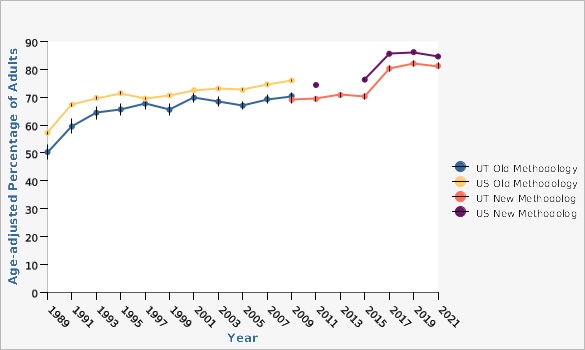
Compared to the U.S., Utah has lower rates of people reporting having their cholesterol checked within the past fie years. However, since 2015 screening rates have been rising in Utah and in the U.S.
| BRFSS Utah vs. U.S. | Year | Age-adjusted Percentage of Adults | Lower Limit | Upper Limit | ||
|---|---|---|---|---|---|---|
Record Count: 34 | ||||||
| UT Old Methodology | 1989 | 50.3% | 47.5% | 53.0% | ||
| UT Old Methodology | 1991 | 59.5% | 56.9% | 62.2% | ||
| UT Old Methodology | 1993 | 64.4% | 61.9% | 66.7% | ||
| UT Old Methodology | 1995 | 65.6% | 63.4% | 67.7% | ||
| UT Old Methodology | 1997 | 67.7% | 65.5% | 69.8% | ||
| UT Old Methodology | 1999 | 65.5% | 63.4% | 67.6% | ||
| UT Old Methodology | 2001 | 69.8% | 68.0% | 71.6% | ||
| UT Old Methodology | 2003 | 68.4% | 66.6% | 70.2% | ||
| UT Old Methodology | 2005 | 67.0% | 65.5% | 68.5% | ||
| UT Old Methodology | 2007 | 69.3% | 67.7% | 70.9% | ||
| UT Old Methodology | 2009 | 70.4% | 69.2% | 71.6% | ||
| US Old Methodology | 1989 | 57.2% | 56.6% | 57.8% | ||
| US Old Methodology | 1991 | 67.4% | 66.8% | 67.9% | ||
| US Old Methodology | 1993 | 69.7% | 69.2% | 70.2% | ||
| US Old Methodology | 1995 | 71.4% | 70.9% | 71.9% | ||
| US Old Methodology | 1997 | 69.5% | 69.1% | 69.9% | ||
| US Old Methodology | 1999 | 70.6% | 70.2% | 70.9% | ||
| US Old Methodology | 2001 | 72.5% | ||||
| US Old Methodology | 2003 | 73.1% | 72.8% | 73.5% | ||
| US Old Methodology | 2005 | 72.6% | 72.3% | 73.0% | ||
| US Old Methodology | 2007 | 74.6% | 74.3% | 74.9% | ||
| US Old Methodology | 2009 | 76.0% | 75.6% | 76.3% | ||
| UT New Methodology | 2009 | 69.1% | 67.9% | 70.2% | ||
| UT New Methodology | 2011 | 69.4% | 68.4% | 70.4% | ||
| UT New Methodology | 2013 | 70.8% | 69.8% | 71.8% | ||
| UT New Methodology | 2015 | 70.3% | 69.2% | 71.3% | ||
| UT New Methodology | 2017 | 80.3% | 79.3% | 81.4% | ||
| UT New Methodology | 2019 | 82.1% | 81.1% | 83.0% | ||
| UT New Methodology | 2021 | 81.2% | 80.2% | 82.3% | ||
| US New Methodology | 2011 | 74.4% | 74.1% | 74.7% | ||
| US New Methodology | 2015 | 76.3% | 76.1% | 76.6% | ||
| US New Methodology | 2017 | 85.6% | 85.3% | 85.8% | ||
| US New Methodology | 2019 | 86.2% | 85.9% | 86.4% | ||
| US New Methodology | 2021 | 84.6% | 84.3% | 84.8% | ||
Data Notes
Beginning in 2011, BRFSS data include both landline and cell phone respondent data along with a new weighting methodology called iterative proportional fitting, or raking. This methodology utilizes additional demographic information (such as education, race, and marital status) in the weighting procedure. Both of these methodology changes were implemented to account for an increased number of U.S. households without landline phones and an under-representation of certain demographic groups that were not well-represented in the sample. More details about these changes can be found at: [https://ibis.health.utah.gov/pdf/opha/resource/brfss/RakingImpact2011.pdf]. Rates are age-adjusted to the U.S. 2000 standard population.Data Sources
- Utah Department of Health and Human Services Behavioral Risk Factor Surveillance System (BRFSS) [https://ibis.health.utah.gov/ibisph-view/query/selection/brfss/BRFSSSelection.html]
- Behavioral Risk Factor Surveillance System Survey Data, US Department of Health and Human Services Centers for Disease Control and Prevention (CDC).
Percentage of Persons Who Reported Having Their Cholesterol Checked Within the Past Five Years (Crude Rates) by Age and Sex, Utah, 2021
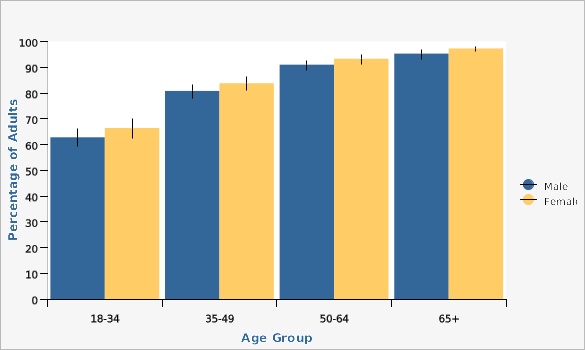
Among adults in the youngest age groups, females had higher screening rates than males.
| Males vs. Females | Age Group | Percentage of Adults | Lower Limit | Upper Limit | ||
|---|---|---|---|---|---|---|
Record Count: 10 | ||||||
| Male | 18-34 | 62.8% | 59.3% | 66.2% | ||
| Male | 35-49 | 80.8% | 78.0% | 83.4% | ||
| Male | 50-64 | 91.0% | 88.8% | 92.8% | ||
| Male | 65+ | 95.3% | 93.1% | 96.8% | ||
| Female | 18-34 | 66.4% | 62.5% | 70.1% | ||
| Female | 35-49 | 83.8% | 80.9% | 86.3% | ||
| Female | 50-64 | 93.3% | 91.1% | 94.9% | ||
| Female | 65+ | 97.3% | 96.2% | 98.1% | ||
Data Notes
Beginning in 2011, BRFSS data include both landline and cell phone respondent data along with a new weighting methodology called iterative proportional fitting, or raking. This methodology utilizes additional demographic information (such as education, race, and marital status) in the weighting procedure. Both of these methodology changes were implemented to account for an increased number of U.S. households without landline phones and an under-representation of certain demographic groups that were not well-represented in the sample. More details about these changes can be found at: [https://ibis.health.utah.gov/pdf/opha/resource/brfss/RakingImpact2011.pdf]. This graph is based on the new methodology.Data Source
Utah Department of Health and Human Services Behavioral Risk Factor Surveillance System (BRFSS) [https://ibis.health.utah.gov/ibisph-view/query/selection/brfss/BRFSSSelection.html]Percentage of Persons Who Reported Having Their Cholesterol Checked Within the Past Five Years by Ethnicity, Utah, 2021
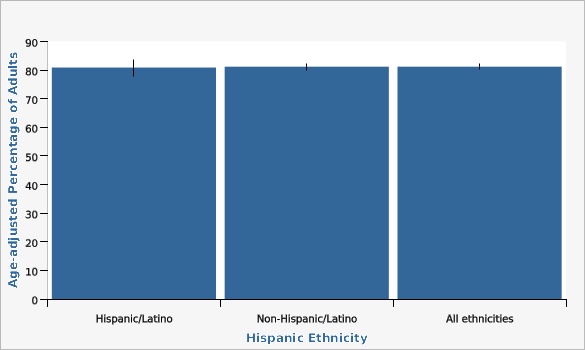
There is no significant difference between Hispanic and non-Hispanic adults reporting having their cholesterol checked within the past five years.
| Hispanic Ethnicity | Age-adjusted Percentage of Adults | Lower Limit | Upper Limit | |||
|---|---|---|---|---|---|---|
Record Count: 3 | ||||||
| Hispanic/Latino | 80.9% | 77.8% | 83.6% | |||
| Non-Hispanic/Latino | 81.2% | 80.0% | 82.3% | |||
| All ethnicities | 81.2% | 80.2% | 82.3% | |||
Data Notes
Beginning in 2011, BRFSS data include both landline and cell phone respondent data along with a new weighting methodology called iterative proportional fitting, or raking. This methodology utilizes additional demographic information (such as education, race, and marital status) in the weighting procedure. Both of these methodology changes were implemented to account for an increased number of U.S. households without landline phones and an under-representation of certain demographic groups that were not well-represented in the sample. More details about these changes can be found at: [https://ibis.health.utah.gov/pdf/opha/resource/brfss/RakingImpact2011.pdf]. This graph is based on the new methodology. Rates are age-adjusted to U.S. 2000 standard population.Data Source
Utah Department of Health and Human Services Behavioral Risk Factor Surveillance System (BRFSS) [https://ibis.health.utah.gov/ibisph-view/query/selection/brfss/BRFSSSelection.html]Percentage of Persons Who Reported Having Their Cholesterol Checked Within the Past Five Years by Race, Utah, 2021
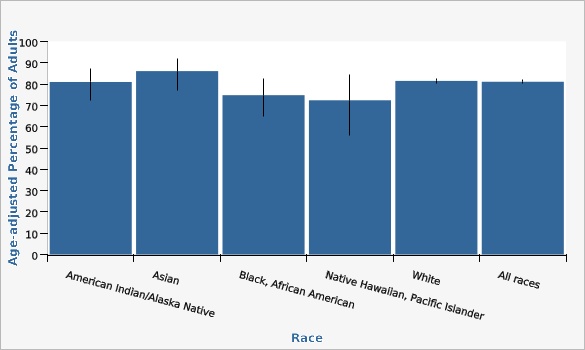
Self-reported rates of cholesterol screening within the past five years did not differ by race.
| Race | Age-adjusted Percentage of Adults | Lower Limit | Upper Limit | |||
|---|---|---|---|---|---|---|
Record Count: 6 | ||||||
| American Indian/Alaska Native | 81.0% | 72.2% | 87.5% | |||
| Asian | 86.1% | 77.2% | 91.9% | |||
| Black, African American | 74.8% | 65.0% | 82.6% | |||
| Native Hawaiian, Pacific Islander | 72.4% | 55.9% | 84.5% | |||
| White | 81.5% | 80.4% | 82.6% | |||
| All races | 81.1% | 80.1% | 82.2% | |||
Data Notes
Beginning in 2011, BRFSS data include both landline and cell phone respondent data along with a new weighting methodology called iterative proportional fitting, or raking. This methodology utilizes additional demographic information (such as education, race, and marital status) in the weighting procedure. Both of these methodology changes were implemented to account for an increased number of U.S. households without landline phones and an under-representation of certain demographic groups that were not well-represented in the sample. More details about these changes can be found at: [https://ibis.health.utah.gov/pdf/opha/resource/brfss/RakingImpact2011.pdf]. This graph is based on the new methodology. Age-adjusted to the U.S. 2000 standard population based on 3 age groups.Data Source
Utah Department of Health and Human Services Behavioral Risk Factor Surveillance System (BRFSS) [https://ibis.health.utah.gov/ibisph-view/query/selection/brfss/BRFSSSelection.html]Percentage of Persons Who Reported Having Their Cholesterol Checked Within the Past Five Years by Income Level, Utah, 2021

Among Utah adults in 2021, as income increases so does the rate of having their cholesterol screened in the past five years.
| Income Category | Age-adjusted Percentage of Persons | Lower Limit | Upper Limit | |||
|---|---|---|---|---|---|---|
Record Count: 5 | ||||||
| <$25,000 | 72.6% | 68.3% | 76.6% | |||
| $25,000-$49,999 | 79.3% | 76.7% | 81.6% | |||
| $50,000-$74,999 | 83.2% | 80.4% | 85.7% | |||
| $75,000+ | 84.5% | 82.7% | 86.1% | |||
| Total | 81.2% | 80.2% | 82.3% | |||
Data Notes
Beginning in 2011, BRFSS data include both landline and cell phone respondent data along with a new weighting methodology called iterative proportional fitting, or raking. This methodology utilizes additional demographic information (such as education, race, and marital status) in the weighting procedure. Both of these methodology changes were implemented to account for an increased number of U.S. households without landline phones and an under-representation of certain demographic groups that were not well-represented in the sample. More details about these changes can be found at: [https://ibis.health.utah.gov/pdf/opha/resource/brfss/RakingImpact2011.pdf]. This graph is based on the new methodology. Age-adjusted to 2000 U.S. standard population.Data Source
Utah Department of Health and Human Services Behavioral Risk Factor Surveillance System (BRFSS) [https://ibis.health.utah.gov/ibisph-view/query/selection/brfss/BRFSSSelection.html]Percentage of Persons Who Reported Having Their Cholesterol Checked Within the Past Five Years by Education Level, Utah, 2021

In 2021, those with some post high school education and college graduates had significantly higher rates of cholesterol screenings than those with a high school education or less.
| Education Level | Age-adjusted Percentage of Persons 25+ | Lower Limit | Upper Limit | |||
|---|---|---|---|---|---|---|
Record Count: 4 | ||||||
| Less than high school | 74.4% | 68.8% | 79.4% | |||
| H.S. grad or G.E.D. | 80.8% | 78.4% | 83.0% | |||
| Some post high school | 85.7% | 83.9% | 87.3% | |||
| College graduate | 88.4% | 87.1% | 89.6% | |||
Data Notes
Beginning in 2011, BRFSS data include both landline and cell phone respondent data along with a new weighting methodology called iterative proportional fitting, or raking. This methodology utilizes additional demographic information (such as education, race, and marital status) in the weighting procedure. Both of these methodology changes were implemented to account for an increased number of U.S. households without landline phones and an under-representation of certain demographic groups that were not well-represented in the sample. More details about these changes can be found at: [https://ibis.health.utah.gov/pdf/opha/resource/brfss/RakingImpact2011.pdf]. Age 25 years old and above. Age-adjusted to 2000 U.S. standard population.Data Source
Utah Department of Health and Human Services Behavioral Risk Factor Surveillance System (BRFSS) [https://ibis.health.utah.gov/ibisph-view/query/selection/brfss/BRFSSSelection.html]| Local Health District | Age-adjusted Percentage of Adults | Lower Limit | Upper Limit | |||
|---|---|---|---|---|---|---|
Record Count: 14 | ||||||
| Bear River | 77.3% | 72.4% | 81.5% | |||
| Central | 73.0% | 67.5% | 77.8% | |||
| Davis County | 84.7% | 81.1% | 87.8% | |||
| Salt Lake County | 82.0% | 80.1% | 83.8% | |||
| San Juan | 74.2% | 64.3% | 82.0% | |||
| Southeast | 77.1% | 68.3% | 84.0% | |||
| Southwest | 75.5% | 70.3% | 80.1% | |||
| Summit | 89.8% | 84.0% | 93.7% | |||
| Tooele | 84.6% | 78.6% | 89.2% | |||
| TriCounty | 75.8% | 71.3% | 79.9% | |||
| Utah County | 83.1% | 81.0% | 85.1% | |||
| Wasatch | 86.1% | 77.5% | 91.7% | |||
| Weber-Morgan | 81.1% | 77.1% | 84.5% | |||
| State of Utah | 81.2% | 80.2% | 82.3% | |||
Data Notes
Beginning in 2011, BRFSS data include both landline and cell phone respondent data along with a new weighting methodology called iterative proportional fitting, or raking. This methodology utilizes additional demographic information (such as education, race, and marital status) in the weighting procedure. Both of these methodology changes were implemented to account for an increased number of U.S. households without landline phones and an under-representation of certain demographic groups that were not well-represented in the sample. More details about these changes can be found at: [https://ibis.health.utah.gov/pdf/opha/resource/brfss/RakingImpact2011.pdf]. [[br]][[br]]Age-adjusted to the U.S. 2000 standard population.Data Source
Utah Department of Health and Human Services Behavioral Risk Factor Surveillance System (BRFSS) [https://ibis.health.utah.gov/ibisph-view/query/selection/brfss/BRFSSSelection.html]Percentage of Persons Who Reported Having Their Cholesterol Checked Within the Past Five Years, by Utah Small Area, 2013, 2015, 2017, 2019, 2021
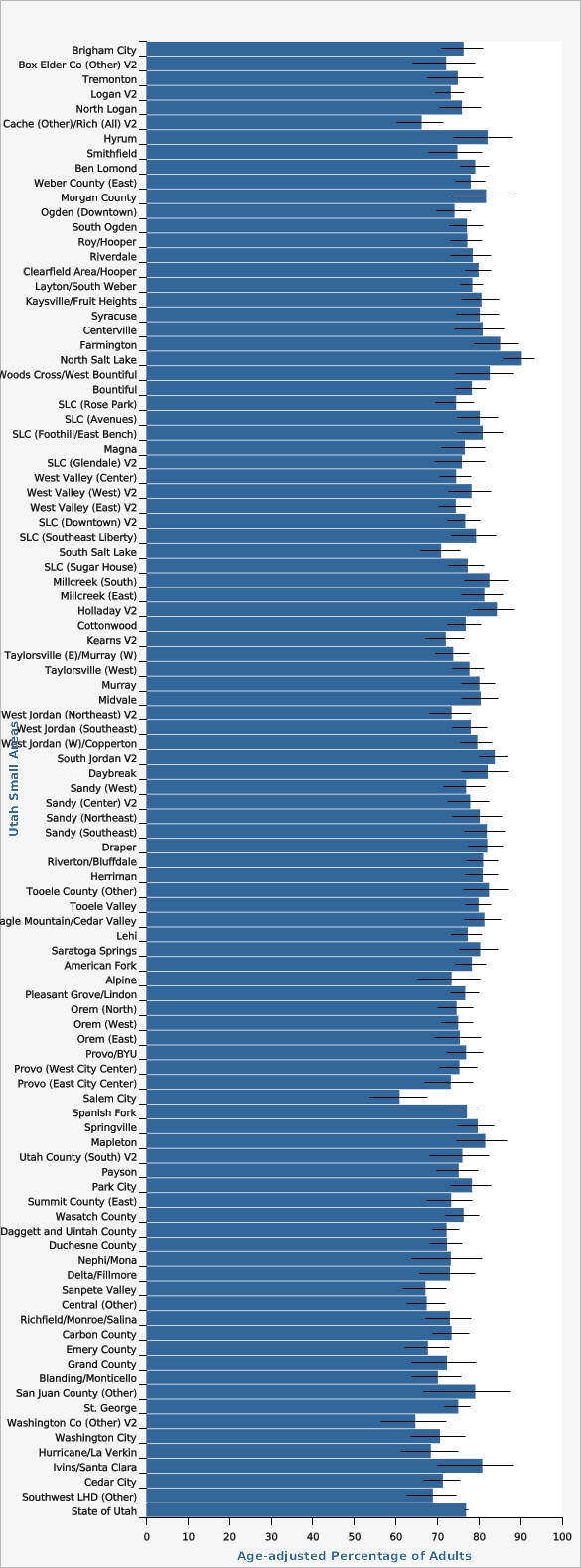
| Utah Small Areas | Age-adjusted Percentage of Adults | Lower Limit | Upper Limit | |||
|---|---|---|---|---|---|---|
Record Count: 100 | ||||||
| Brigham City | 76.3% | 71.0% | 80.9% | |||
| Box Elder Co (Other) V2 | 72.1% | 64.0% | 79.0% | |||
| Tremonton | 74.9% | 67.6% | 81.0% | |||
| Logan V2 | 73.2% | 69.6% | 76.5% | |||
| North Logan | 75.9% | 70.6% | 80.5% | |||
| Cache (Other)/Rich (All) V2 | 66.2% | 60.3% | 71.5% | |||
| Hyrum | 82.1% | 73.9% | 88.1% | |||
| Smithfield | 74.8% | 67.8% | 80.7% | |||
| Ben Lomond | 79.1% | 75.4% | 82.4% | |||
| Weber County (East) | 78.0% | 74.2% | 81.5% | |||
| Morgan County | 81.7% | 73.3% | 87.9% | |||
| Ogden (Downtown) | 74.1% | 69.7% | 78.1% | |||
| South Ogden | 77.1% | 72.8% | 80.9% | |||
| Roy/Hooper | 77.2% | 73.2% | 80.8% | |||
| Riverdale | 78.5% | 73.2% | 83.0% | |||
| Clearfield Area/Hooper | 79.9% | 76.7% | 82.8% | |||
| Layton/South Weber | 78.4% | 75.4% | 81.1% | |||
| Kaysville/Fruit Heights | 80.6% | 75.7% | 84.8% | |||
| Syracuse | 80.2% | 74.5% | 84.8% | |||
| Centerville | 80.9% | 74.1% | 86.1% | |||
| Farmington | 85.1% | 78.9% | 89.7% | |||
| North Salt Lake | 90.3% | 85.7% | 93.5% | |||
| Woods Cross/West Bountiful | 82.6% | 74.4% | 88.5% | |||
| Bountiful | 78.3% | 74.4% | 81.8% | |||
| SLC (Rose Park) | 74.5% | 69.5% | 78.9% | |||
| SLC (Avenues) | 80.2% | 74.8% | 84.6% | |||
| SLC (Foothill/East Bench) | 80.9% | 74.8% | 85.7% | |||
| Magna | 76.6% | 70.9% | 81.5% | |||
| SLC (Glendale) V2 | 75.9% | 69.3% | 81.4% | |||
| West Valley (Center) | 74.5% | 70.6% | 78.1% | |||
| West Valley (West) V2 | 78.2% | 72.6% | 83.0% | |||
| West Valley (East) V2 | 74.4% | 70.2% | 78.2% | |||
| SLC (Downtown) V2 | 76.7% | 72.5% | 80.4% | |||
| SLC (Southeast Liberty) | 79.3% | 73.3% | 84.2% | |||
| South Salt Lake | 70.9% | 65.9% | 75.5% | |||
| SLC (Sugar House) | 77.3% | 72.7% | 81.3% | |||
| Millcreek (South) | 82.5% | 76.4% | 87.3% | |||
| Millcreek (East) | 81.3% | 75.8% | 85.9% | |||
| Holladay V2 | 84.3% | 78.6% | 88.7% | |||
| Cottonwood | 76.8% | 72.5% | 80.6% | |||
| Kearns V2 | 72.0% | 67.1% | 76.5% | |||
| Taylorsville (E)/Murray (W) | 73.8% | 69.5% | 77.7% | |||
| Taylorsville (West) | 77.7% | 73.5% | 81.3% | |||
| Murray | 80.1% | 75.8% | 83.8% | |||
| Midvale | 80.4% | 75.7% | 84.5% | |||
| West Jordan (Northeast) V2 | 73.4% | 68.1% | 78.2% | |||
| West Jordan (Southeast) | 78.0% | 73.6% | 81.9% | |||
| West Jordan (W)/Copperton | 79.6% | 75.5% | 83.1% | |||
| South Jordan V2 | 83.8% | 80.1% | 86.9% | |||
| Daybreak | 82.1% | 75.7% | 87.1% | |||
| Sandy (West) | 76.9% | 71.4% | 81.6% | |||
| Sandy (Center) V2 | 77.9% | 72.5% | 82.4% | |||
| Sandy (Northeast) | 80.2% | 73.7% | 85.5% | |||
| Sandy (Southeast) | 81.9% | 76.5% | 86.3% | |||
| Draper | 82.0% | 77.4% | 85.8% | |||
| Riverton/Bluffdale | 81.0% | 77.0% | 84.5% | |||
| Herriman | 80.9% | 76.6% | 84.5% | |||
| Tooele County (Other) | 82.4% | 76.2% | 87.3% | |||
| Tooele Valley | 79.9% | 76.8% | 82.8% | |||
| Eagle Mountain/Cedar Valley | 81.3% | 76.5% | 85.3% | |||
| Lehi | 77.3% | 73.4% | 80.7% | |||
| Saratoga Springs | 80.3% | 75.3% | 84.5% | |||
| American Fork | 78.3% | 74.3% | 81.8% | |||
| Alpine | 73.4% | 65.2% | 80.3% | |||
| Pleasant Grove/Lindon | 76.7% | 73.1% | 80.0% | |||
| Orem (North) | 74.6% | 70.0% | 78.6% | |||
| Orem (West) | 75.0% | 71.0% | 78.7% | |||
| Orem (East) | 75.4% | 69.4% | 80.6% | |||
| Provo/BYU | 76.9% | 72.2% | 81.0% | |||
| Provo (West City Center) | 75.3% | 70.5% | 79.6% | |||
| Provo (East City Center) | 73.2% | 66.9% | 78.7% | |||
| Salem City | 60.9% | 53.8% | 67.6% | |||
| Spanish Fork | 77.1% | 73.2% | 80.5% | |||
| Springville | 79.7% | 74.9% | 83.7% | |||
| Mapleton | 81.5% | 74.5% | 86.8% | |||
| Utah County (South) V2 | 76.0% | 68.2% | 82.4% | |||
| Payson | 75.1% | 69.8% | 79.8% | |||
| Park City | 78.3% | 73.0% | 82.8% | |||
| Summit County (East) | 73.3% | 67.5% | 78.4% | |||
| Wasatch County | 76.3% | 71.9% | 80.1% | |||
| Daggett and Uintah County | 72.2% | 68.9% | 75.2% | |||
| Duchesne County | 72.3% | 68.1% | 76.1% | |||
| Nephi/Mona | 73.2% | 63.9% | 80.8% | |||
| Delta/Fillmore | 73.0% | 65.8% | 79.2% | |||
| Sanpete Valley | 67.1% | 61.6% | 72.1% | |||
| Central (Other) | 67.4% | 62.6% | 71.9% | |||
| Richfield/Monroe/Salina | 73.0% | 67.2% | 78.1% | |||
| Carbon County | 73.4% | 68.7% | 77.6% | |||
| Emery County | 67.7% | 62.1% | 72.8% | |||
| Grand County | 72.3% | 63.9% | 79.4% | |||
| Blanding/Monticello | 70.1% | 63.7% | 75.8% | |||
| San Juan County (Other) | 79.1% | 66.6% | 87.8% | |||
| St. George | 75.0% | 71.8% | 77.9% | |||
| Washington Co (Other) V2 | 64.7% | 56.3% | 72.2% | |||
| Washington City | 70.6% | 63.5% | 76.8% | |||
| Hurricane/La Verkin | 68.4% | 61.1% | 75.0% | |||
| Ivins/Santa Clara | 80.8% | 70.1% | 88.3% | |||
| Cedar City | 71.3% | 66.7% | 75.4% | |||
| Southwest LHD (Other) | 68.9% | 62.7% | 74.5% | |||
| State of Utah | 76.9% | 76.4% | 77.3% | |||
Data Notes
Beginning in 2011, BRFSS data include both landline and cell phone respondent data along with a new weighting methodology called iterative proportional fitting, or raking. This methodology utilizes additional demographic information (such as education, race, and marital status) in the weighting procedure. Both of these methodology changes were implemented to account for an increased number of U.S. households without landline phones and an under-representation of certain demographic groups that were not well-represented in the sample. More details about these changes can be found at: [https://ibis.health.utah.gov/pdf/opha/resource/brfss/RakingImpact2011.pdf]. Age-adjusted to the 2000 U.S. standard population.Data Source
Utah Department of Health and Human Services Behavioral Risk Factor Surveillance System (BRFSS) [https://ibis.health.utah.gov/ibisph-view/query/selection/brfss/BRFSSSelection.html]References and Community Resources
Heart disease and stroke are the first and fourth leading causes of death in the United States. Heart disease is responsible for 1 of every 3 deaths in the country. Million Hearts is a national initiative that has set an ambitious goal to prevention 1 million heart attacks and strokes by 2017. The impact will be even greater over time. Million Hearts aims to prevent heart disease and stroke by:[[br]] -Improving access to effective care[[br]] -Improving the quality of care for the ABCS (appropriate aspirin prescription, blood pressure control, cholesterol control, and smoking cessation)[[br]] -Focusing clinical attention on the prevention of heart attack and stroke [[br]] -Activating the public to lead a heart-healthy lifestyle[[br]] -Improving the prescription and adherence to appropriate medications for the ABCS See what you can do to be part of the solution. Click [https://comagine.org/program/utah-million-hearts-coalition here] for more information. For information about the Million Hearts initiative, please visit [https://millionhearts.hhs.gov/]. For more information on how Utah compares to the U.S. and other states for cholesterol screening please click [https://nccd.cdc.gov/BRFSSPrevalence/rdPage.aspx?rdReport=DPH_BRFSS.ExploreByTopic&irbLocationType=StatesAndMMSA&islClass=CLASS02&islTopic=TOPIC11&islYear=2019&rdRnd=9035 here].More Resources and Links
Evidence-based community health improvement ideas and interventions may be found at the following sites:- Centers for Disease Control and Prevention (CDC) WONDER Database, a system for disseminating public health data and information.
- United States Census Bureau data dashboard.
- Utah healthy Places Index, evidence-based and peer-reviewed tool, supports efforts to prioritize equitable community investments, develop critical programs and policies across the state, and much more.
- County Health Rankings
- Kaiser Family Foundation's StateHealthFacts.org
- Medical literature can be queried at PubMed library.
Page Content Updated On 03/04/2024,
Published on 03/27/2024

